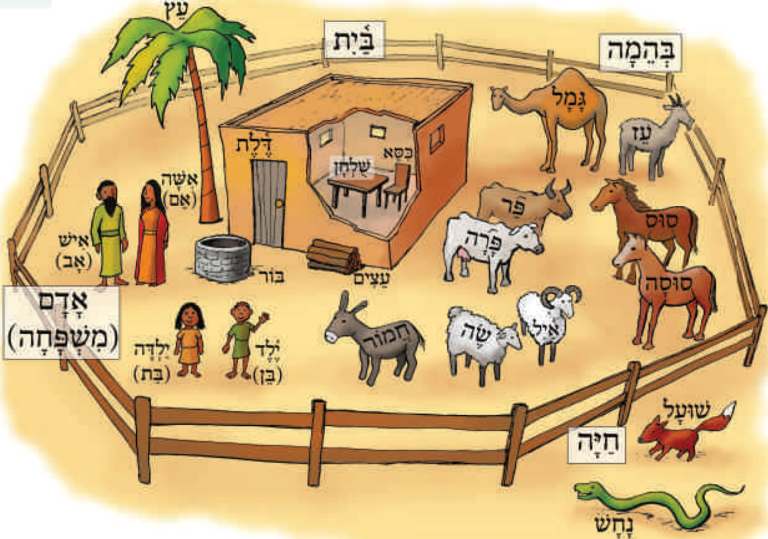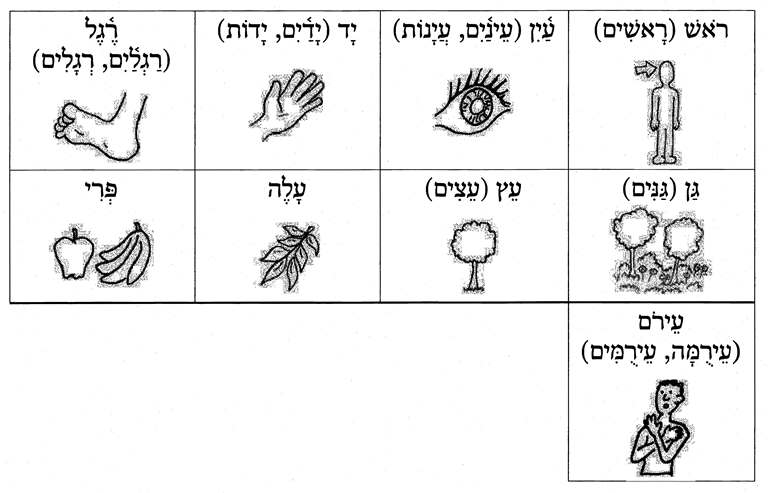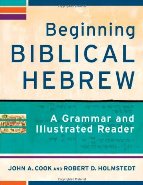Distinctives
This textbook has seven (often interrelated) distinctives that justify its creation amid the mass of currently available textbooks.
1. Learning an Ancient Language and Second-Language Acquisition
We have sought to incorporate more recent ideas about pedagogy into the shaping of the grammar explanations and the exercises. The most obvious feature of the textbook represents its unique strength: the use of illustrated episodes from Genesis to learn Hebrew. Moreover, all the exercises based on the illustrated readings use as much Hebrew as possible. That is, we avoid using the model that dominates in other textbooks: the grammar-translation model. Instead of teaching Hebrew as an object to be decoded and then recoded into the students’ native language (e.g., English), the goal of this textbook is to provide the student with competency in reading, listening, and even producing Hebrew. In other words, rather than mastering Hebrew for translation, our aim is that students achieve the ability to comprehend Biblical Hebrew texts. At the same time, we admit practical limits to such second-language acquisition approaches in the teaching and learning of ancient, textual corpus-bound languages. As such, there remains a philological realism to our pedagogy coupled with our use of second-language acquisition (SLA) techniques. In particular, the exercises included in the textbook center around self-contained narratives from the Bible and include visual and audio aids for vocabulary memorization and narrative comprehension. In addition, we have provided additional audiovisual aids for developing oral fluency. Beyond this, there is choice: the instructor may maintain a text-based atmosphere, focusing on the given exercises, or establish a conversation-based atmosphere, in
which the given exercises are used as a platform for extemporaneous modification (and thus greater competency in the productive aspect of learning Hebrew).
2. Language Pedagogy and Grammar Presentation
One of the points of dissatisfaction with grammars currently on the market is that they tend to provide too much grammatical information for a first-year textbook. The effect is that students are overwhelmed and instructors are faced with cutting out the unnecessary clutter. Rather than produce a textbook that is a stand-in for an intermediate grammar, we have included a minimal amount of grammar to give students facility in reading actual Hebrew texts, and we have left to the instructor’s discretion the introduction of more advanced descriptions. To put it in SLA terms, our selection of grammar in the textbook has been guided by the goal of acquiring the ancient Hebrew language as opposed to simply learning its grammar. Organizationally, the most notable result of this approach is our decision to relegate summaries of weak verb forms to an appendix, along with the customary verb paradigms. In this way we aim to give these discussions their proper place in grammar study, as explanations of forms in the context of reading texts rather than complex morphological explanations abstracted from the practice and skills of reading Hebrew.
The organization of the textbook centers around discrete grammatical issues. The lessons do not present the grammar in the traditional sequence of phonologymorphology-syntax, but recognize that language is learned in small chunks of information that alternate through the various aspects of grammar (including a greater focus on syntax and semantics, areas neglected by current introductory textbooks). The material is also organized to maximize the use of repetition, a key to language acquisition. For example, paradigms are often broken into halves, so that presentation of the second half reinforces the material already learned.
4. Text-Based Exercises
The lessening of the morphology burden in the grammar has allowed us space to incorporate discussions of grammar that are conducive to reading and understanding Hebrew literature. In particular, we have several lessons that introduce students to important aspects of the syntactic, semantic, and pragmatic systems of Biblical Hebrew, illustrated with examples from the same texts (Genesis episodes) used for the exercises.
5. Recognition of the Diversity of Hebrew in the Bible
Our choice of a particular corpus (discrete episodes from Genesis) from which to draw examples for the discussion of Hebrew syntax, semantics, and pragmatics comes out of a recognition that Biblical Hebrew is not a monolithic or uniform language. Rather, preserved in the biblical corpus and extrabiblical ancient epigraphs and texts (e.g., Ben Sira, Qumran) is an array of grammatical peculiarities and divergences. Rather than fall into the philological trap of trying to be exhaustive, we have chosen to focus our analysis and draw our examples from a small, uniform corpus of prose literature appropriate for first-year readings.
6. Modern Linguistic Background
Our textbook incorporates more recent linguistic explanations of Biblical Hebrew in a way that is as jargon-free as possible and understandable to beginning students. The currently available textbooks of Biblical Hebrew are often astonishingly behind the times in their grammar descriptions and terminology. Nineteenth-century theories of the Hebrew verb continue to be presented not because they are correct, but because they “work.” However, we are convinced that explanations should be presented that are both accurate and understandable. Biblical Hebrew grammar instruction has also been plagued with idiosyncratic and archaic vocabulary. In place of outmoded Latinate terms such as status constructus, we have sought to employ terms native to language itself and/or in current use in Hebrew linguistic studies, such as nismach.
7. Nonconfessional Orientation
The textbook is nonconfessional. Religious and theological aims for studying Biblical Hebrew have shaped the concerns of many textbooks to the point that they sometimes wed their grammar lessons to theological insights from the text. Such overtly confessional approaches unnecessarily preclude other interests in studying Hebrew, such as cultural or linguistic insights. Although we are not averse to confessional approaches to the Bible (one author teaches at a theological seminary), we think that a textbook written without a confessional stance will serve a wider community of language learners and institutions.
(John A. Cook and Robert D. Holmstedt, Beginning Biblical Hebrew. Baker Academic, a division of Baker Publishing Group, 2013. Used by permission. www.bakerpublishinggroup.com)
Note: And we might add another distinctive: where else can you learn Hebrew with these kinds of visual aids?


Buy the books

Beginning Biblical Hebrew
